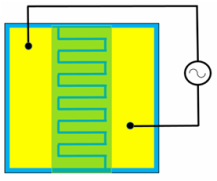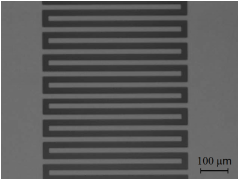Airborne Chemical Sensors
|
|
Selected Publications
|
There exists a significant need for low-cost, lightweight, and robust point detectors for explosive materials. Current deployable explosives and toxic chemical sensing methods utilize ion mobility mass spectrometry, gas chromatograph mass spectrometry, X-ray imaging, Raman spectroscopy, and other such techniques. While these techniques are highly selective, each method has its own shortcomings, such as low resolution, competing ion or molecule side reactions, response variation from different compositions of analytes, limited response range, and time-consumption. In addition, most of these techniques are bulky and require significant training for proper utilization. A potential alternative approach to sense explosives and other toxic chemicals while circumventing the aforementioned shortcomings is to exploit dielectric materials as part of a rudimentary circuit or system.
Our objective is the creation of airborne explosive chemical detectors utilizing interdigitated capacitor (IDC) device geometries spanned by metal-oxide nanoparticle thin films formed by ultrasonic spray deposition. In such a device, even small amounts of exposure will make a measurable, frequency-dependent impedance shift. We will leverage our recent research on oxides to choose robust materials that have shown both selectivity and high sensitivity to explosives and related compounds. The IDC element will be placed in a small, simple circuit that tests the impedance at any number of frequencies, for real time detection and differentiation of the frequency-dependent “shift fingerprint.” Such a device could be modified to be placed upon flexible substrates or wearable patches.
Our objective is the creation of airborne explosive chemical detectors utilizing interdigitated capacitor (IDC) device geometries spanned by metal-oxide nanoparticle thin films formed by ultrasonic spray deposition. In such a device, even small amounts of exposure will make a measurable, frequency-dependent impedance shift. We will leverage our recent research on oxides to choose robust materials that have shown both selectivity and high sensitivity to explosives and related compounds. The IDC element will be placed in a small, simple circuit that tests the impedance at any number of frequencies, for real time detection and differentiation of the frequency-dependent “shift fingerprint.” Such a device could be modified to be placed upon flexible substrates or wearable patches.
(left) Cartoon schematic for the proposed interdigitated capacitor device. Green: nanoparticle thin film. Yellow: metal electrodes. (right) Initial interdigitated capacitor structure result under a microscope, metal electrode choice in this picture is chromium for photography purposes.



